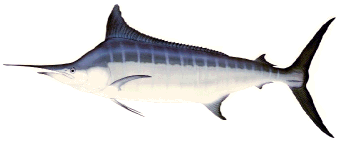CAUSE OF FISHERY DECLINES
The major cause for most fishery population declines has been broadly attributed to overfishing (including wasteful fishery practices).� However, we now have substantial evidence, particularly from the former Soviet Union and from our own Atlantic, Gulf of Mexico, and Pacific coasts, that many inshore-dependent populations are also being affected by cumulative habitat degradation and loss (Chambers 1992).� The most significant human-induced causes of living marine resources' habitat degradation, in order of their importance, are:� depletion and alterations in freshwater flows, physical habitat degradation, toxic contaminants, and nutrient over-enrichment.� Each of these threatsis described in more detail on other pages at this site (see links below).� However, two regional examples serve to illustrate both the significance and the complexity of national habitat degradation problems.
Chesapeake Bay, the nation's largest estuary, provides habitat for 287 known fish species.� Inshore-dependent species constitute 97%, if measured by weight (and 71%, if by value), of the Bay's 1991 commercial landings of fish and shellfish.� Between 1966 and 1985, landings of migratory species declined 82%, including:� hickory shad (96%), alewife and blueback herring (92%), striped bass (70%), American shad (66%), white perch (51%), and yellow perch (72%) (CBP 1988).� Due to stringent harvest restrictions, striped bass seem to be making a slight recovery.� In 1992, blue crab catches were down 43% compared to the previous year (due primarily to heavy fishing pressure).� The Bay's production of oysters is now only 1% of levels harvested a century ago (Newell 1987) - primarily as a result of mechanical destruction of habitat by harvesting and overfishing (Rothschild, et al. 1994) and more recently reduced still more, with increasing population density in the watershed, by gradual ecosystem degradation, disease (MSX and 'dermo'), and parasites.� According to the Chesapeake Bay Foundation, half of the Bay's wetlands and 40% of its forested areas have been destroyed.� 90% of its former seagrass meadows, the prime nursery habitat, have been lost.� More oil washes down the watershed's storm drains each year than was spilled by the ExxonValdez.� Some 3 million more people are expected to settle around the Bay by the year 2020, and the population of the Bay's watershed will double in less than 70 years.� Overfishing, habitat loss, oxygen depletion, and pollution add to the stress on the Bay's fish and shellfish populations making them more susceptible to disease, predators, and natural stress in a complex manner.
Sabine Lake is a large estuarine area between Texas and Louisiana that for years produced abundant white shrimp harvests.� Shrimp populations are determined by the quantity and quality of coastal wetland nursery habitat (Turner 1977) for their survival and growth to a size at which they can be harvested commercially or recreationally.� Navigation channels from the Gulf of Mexico were dredged up the length of Sabine Lake and at its margins;� many of its bordering wetlands were levied off and filled for industrial development;� and two reservoirs were constructed upstream.� As a result of cumulative ecosystem degradation, this valuable fishery collapsed (Sheridan et al. 1989).
GO TO
Habitat Protection Division
Inshore-Dependent Fish and Shellfish
Wetland Destruction
Dams and Flow Diversions
Toxic Contaminants
Nutrient Over-Enrichment
Cumulative Effects
Economic Benefits of Effective Habitat Protection
References
Headed for Extinction
Chambers and Associates - Overview
Description of the Firm
Pages on this Website

Chambers and Associates
9814 Kensington Parkway
Kensington, Maryland 20895
(T) (301) 949-3003�� (Fax) (301) 949-3003
Email�� [email protected]
Website�� Chambers-Associates.org
Blue Marlin Logo by Artist Ron Pittard